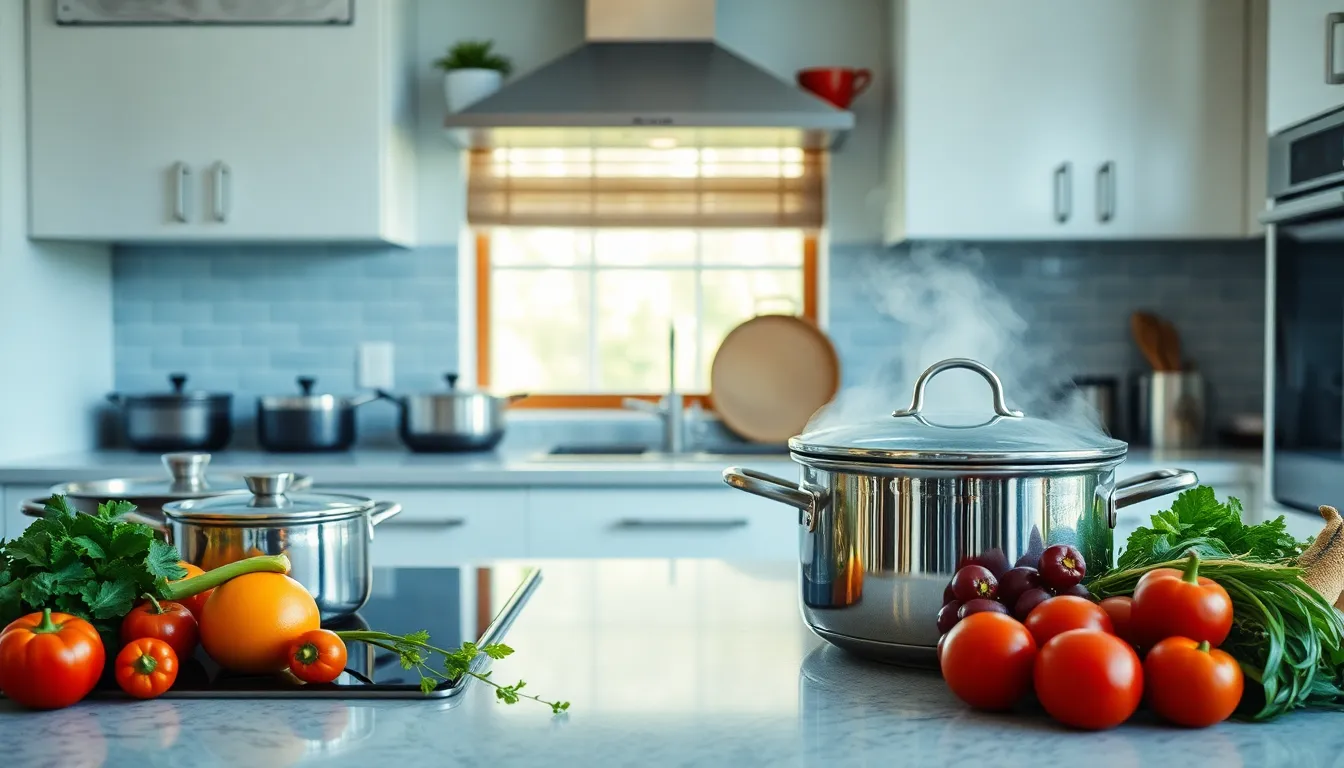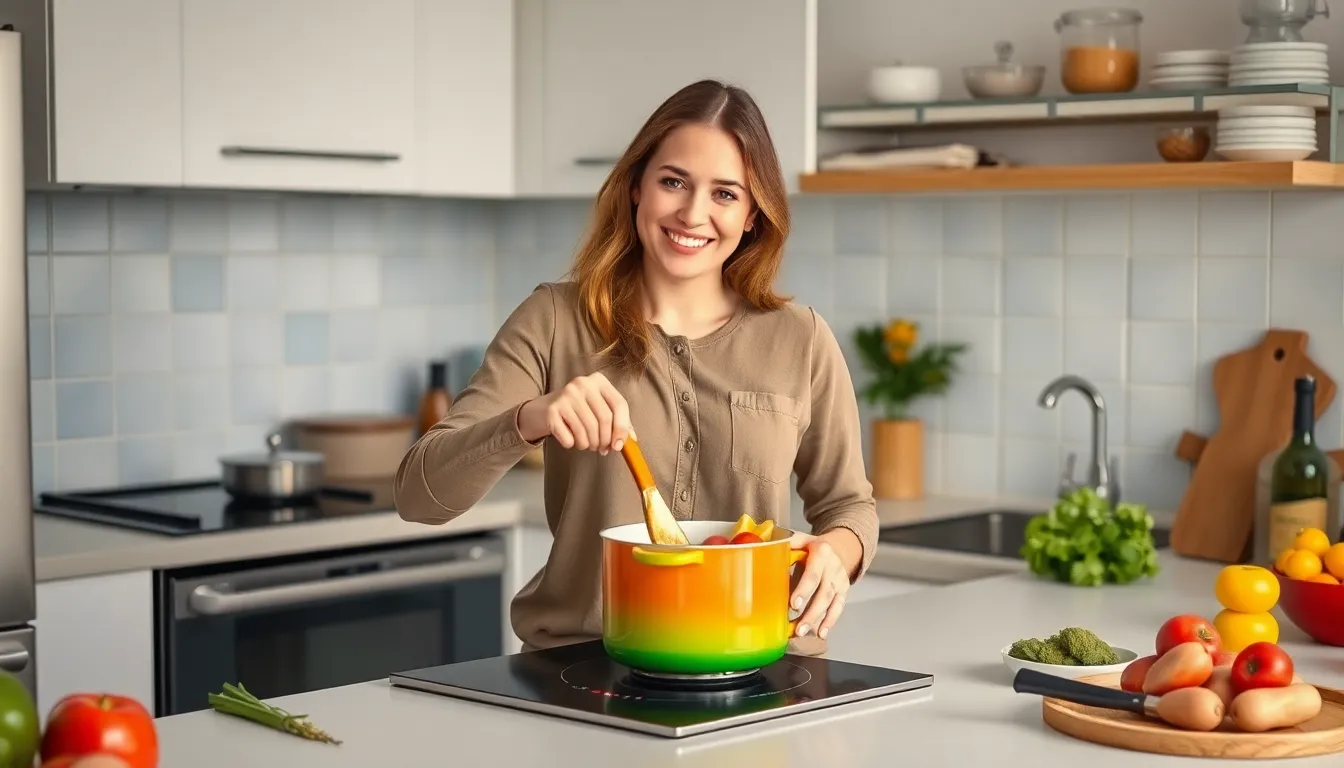In a world where energy bills can feel like a second mortgage, energy-efficient cooking is the superhero we didn’t know we needed. Imagine whipping up a gourmet meal while saving the planet and your wallet. It’s like discovering a secret recipe that not only satisfies your taste buds but also keeps your conscience clear.
From clever gadgets to simple techniques, energy-efficient cooking isn’t just for eco-warriors. It’s for anyone who enjoys delicious food without the guilt of skyrocketing energy costs. So, grab your apron and prepare to turn your kitchen into an efficiency powerhouse. Who knew saving energy could be this much fun?
Table of Contents
ToggleOverview of Energy-Efficient Cooking
Energy-efficient cooking encompasses various methods and techniques aimed at reducing energy consumption in the kitchen. This approach contributes to lower utility bills and promotes sustainability. Numerous appliances and tools facilitate energy efficiency, such as induction cooktops and pressure cookers.
Utilizing pots and pans made from materials with high thermal conductivity enhances cooking efficiency. Improved heat retention reduces cooking time and energy usage, making meals faster and more economical. Utilizing lids on pots locks in heat and moisture, further minimizing energy loss.
Adopting batch cooking practices decreases energy use by preparing multiple meals at once, leading to less energy spent on individual cooking sessions. Coordinating cooking times allows for the use of residual heat; for example, finishing a dish with heat from a previously used oven saves energy.
Storage options also play a crucial role in energy-efficient cooking. Accurate organization of kitchen gadgets, cookware, and perishables streamlines meal prep and reduces the energy required for searching and accessing items.
Many cooking techniques contribute to energy-efficient practices. Steaming, for instance, utilizes less energy compared to boiling, while sautéing may require less time and energy than baking. Emphasizing smaller portion sizes can lead to quicker cooking times, ultimately conserving energy.
Exploring energy-efficient cooking provides practical strategies that anyone can implement, making it accessible to a wide audience. Embracing these techniques and gadgets can transform the cooking experience, making it more enjoyable and rewarding while supporting environmental goals.
Benefits of Energy-Efficient Cooking

Energy-efficient cooking brings multiple advantages, making it an appealing choice for many. It enhances cost savings and significantly reduces environmental impact.
Cost Savings
Energy-efficient cooking methods directly lead to lower energy bills. Using appliances like induction cooktops minimizes electricity usage and cooks food faster. Transitioning to pressure cookers cuts cooking time, utilizing less energy for the same meal. Batch cooking promotes efficiency by preparing several meals at once, reducing overall energy expense. Optimizing cookware choices also aids in maintaining heat, meaning less energy is needed to achieve desired temperatures. Keeping lids on pots prevents heat loss, resulting in further cost reductions. Alongside smart appliance choices, these techniques collectively contribute to noticeable savings on household energy expenses.
Environmental Impact
Cooking with energy-efficient practices significantly lessens one’s carbon footprint. Utilizing less energy reduces greenhouse gas emissions associated with conventional cooking methods. Induction cooktops generate fewer emissions than traditional gas stoves, making them a cleaner option. Cooking methods such as steaming or sautéing consume less energy and produce fewer pollutants. Employing energy-efficient appliances encourages sustainable consumption patterns and promotes cleaner energy sources. Embracing these techniques aligns with global efforts to reduce energy consumption and conserve resources. Supporting the environment through energy-efficient cooking creates a more sustainable future for generations to come.
Techniques for Energy-Efficient Cooking
Energy-efficient cooking combines smart choices and clever techniques. These methods not only minimize energy consumption but also enhance the cooking experience.
Using Efficient Appliances
Selecting efficient appliances makes a significant difference. Induction cooktops offer rapid heating and reduce energy use significantly compared to conventional stoves. Energy Star-rated appliances consume up to 50% less energy than standard models, providing substantial savings. Pressure cookers rapidly cook food, cutting energy consumption by up to 70%. Slow cookers also enable energy savings, letting meals simmer with minimal power usage. Dishwashers, when run only with full loads, can be more energy-efficient than washing dishes by hand. Ultimately, choosing the right appliances enhances efficiency and lowers utility bills.
Cooking Methods
Adopting specific cooking methods boosts energy savings. Steaming, for example, retains nutrients and uses less energy compared to boiling. Sautéing requires less time and heat, making it an optimal choice for quick meals. Baking large batches at once maximizes oven use, promoting efficiency. Utilizing lids on pots retains heat, decreasing cooking energy. Cooking with residual heat, such as turning off the oven before food finishes cooking, optimizes energy usage. Finally, using a microwave for reheating is often more energy-efficient than using a stove or oven. These methods lead to effective cooking while conserving resources.
Tips for Implementing Energy-Efficient Cooking
Energy-efficient cooking enhances cost savings and reduces environmental impact. Simple adjustments in the kitchen lead to smarter energy use.
Meal Planning
Planning meals in advance minimizes waste and reduces energy consumption. By organizing weekly menus, individuals can streamline grocery shopping and avoid unnecessary trips. Preparing larger quantities allows them to utilize energy more effectively as they can cook multiple meals at once. Setting aside specific days for meal prep maximizes the use of appliances while ensuring optimal cooking times. This approach not only conserves energy but also simplifies cooking during busy weeks.
Optimal Use of Resources
Utilizing kitchen resources efficiently lowers energy usage. Choosing appliances with Energy Star ratings brings immediate savings. Cooking with lids on pots and using flat-bottomed pans on induction cooktops enhances heat retention, reducing cooking time. Storing pots and pans within reach minimizes energy spent searching for tools, enabling quicker food preparation. Recycling and reusing ingredients fosters a resourceful kitchen environment, encouraging sustainability in everyday cooking.
Embracing energy-efficient cooking transforms the kitchen experience into something both enjoyable and sustainable. By adopting smart techniques and utilizing efficient appliances, anyone can significantly reduce their energy consumption while saving on bills.
The shift towards energy efficiency not only benefits individual households but also contributes to a healthier planet. With a few simple changes and mindful practices, cooking can become a rewarding endeavor that aligns with environmental goals.
Ultimately, the journey toward energy-efficient cooking is one of empowerment, offering practical solutions that make a difference in everyday life.





